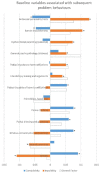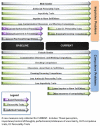Fractionation of impulsive and compulsive trans-diagnostic phenotypes and their longitudinal associations
- PMID: 31001986
- PMCID: PMC6724459
- DOI: 10.1177/0004867419844325
Fractionation of impulsive and compulsive trans-diagnostic phenotypes and their longitudinal associations
Abstract
Objective: Young adulthood is a crucial neurodevelopmental period during which impulsive and compulsive problem behaviours commonly emerge. While traditionally considered diametrically opposed, impulsive and compulsive symptoms tend to co-occur. The objectives of this study were as follows: (a) to identify the optimal trans-diagnostic structural framework for measuring impulsive and compulsive problem behaviours, and (b) to use this optimal framework to identify common/distinct antecedents of these latent phenotypes.
Method: In total, 654 young adults were recruited as part of the Neuroscience in Psychiatry Network, a population-based cohort in the United Kingdom. The optimal trans-diagnostic structural model capturing 33 types of impulsive and compulsive problem behaviours was identified. Baseline predictors of subsequent impulsive and compulsive trans-diagnostic phenotypes were characterised, along with cross-sectional associations, using partial least squares.
Results: Current problem behaviours were optimally explained by a bi-factor model, which yielded dissociable measures of impulsivity and compulsivity, as well as a general disinhibition factor. Impulsive problem behaviours were significantly explained by prior antisocial and impulsive personality traits, male gender, general distress, perceived dysfunctional parenting and teasing/arguments within friendships. Compulsive problem behaviours were significantly explained by prior compulsive traits and female gender.
Conclusion: This study demonstrates that trans-diagnostic phenotypes of 33 impulsive and compulsive problem behaviours are identifiable in young adults, utilising a bi-factor model based on responses to a single questionnaire. Furthermore, these phenotypes have different antecedents. The findings yield a new framework for fractionating impulsivity and compulsivity, and suggest different early intervention targets to avert emergence of problem behaviours. This framework may be useful for future biological and clinical dissection of impulsivity and compulsivity.
Keywords: Impulsive; compulsive; phenotyping.
Conflict of interest statement
Figures



Similar articles
-
Latent traits of impulsivity and compulsivity: toward dimensional psychiatry.Psychol Med. 2018 Apr;48(5):810-821. doi: 10.1017/S0033291717002185. Epub 2017 Aug 14. Psychol Med. 2018. PMID: 28805173 Free PMC article.
-
Brain micro-architecture and disinhibition: a latent phenotyping study across 33 impulsive and compulsive behaviours.Neuropsychopharmacology. 2021 Jan;46(2):423-431. doi: 10.1038/s41386-020-00848-9. Epub 2020 Sep 12. Neuropsychopharmacology. 2021. PMID: 32919402 Free PMC article.
-
A psychometric validation study of the Impulsive-Compulsive Behaviours Checklist: A transdiagnostic tool for addictive and compulsive behaviours.Addict Behav. 2017 Apr;67:26-33. doi: 10.1016/j.addbeh.2016.11.021. Epub 2016 Dec 2. Addict Behav. 2017. PMID: 27987424
-
Trans-diagnostic measurement of impulsivity and compulsivity: A review of self-report tools.Neurosci Biobehav Rev. 2021 Jan;120:455-469. doi: 10.1016/j.neubiorev.2020.10.007. Epub 2020 Oct 25. Neurosci Biobehav Rev. 2021. PMID: 33115636 Free PMC article. Review.
-
Compulsivity, impulsivity, and the DSM-5 process.CNS Spectr. 2014 Feb;19(1):62-8. doi: 10.1017/S1092852913000722. Epub 2013 Nov 7. CNS Spectr. 2014. PMID: 24229702 Review.
Cited by
-
The place of obsessive-compulsive and related disorders in the compulsive-impulsive spectrum: a cluster-analytic study.CNS Spectr. 2021 Apr 12;27(4):1-10. doi: 10.1017/S109285292100033X. Online ahead of print. CNS Spectr. 2021. PMID: 33843555 Free PMC article.
-
Exploring the neurobiology of OCD: clinical implications.Psychiatr Times. 2020 Mar 2;2020:exploring-neurobiology-ocd-clinical-implications. Psychiatr Times. 2020. PMID: 32624642 Free PMC article. No abstract available.
-
Eating disorders with over-exercise: A cross-sectional analysis of the mediational role of problematic usage of the internet in young people.J Psychiatr Res. 2021 Jan;132:215-222. doi: 10.1016/j.jpsychires.2020.11.004. Epub 2020 Nov 4. J Psychiatr Res. 2021. PMID: 33189357 Free PMC article.
-
A Novel, Expert-Endorsed, Neurocognitive Digital Assessment Tool for Addictive Disorders: Development and Validation Study.J Med Internet Res. 2023 Aug 25;25:e44414. doi: 10.2196/44414. J Med Internet Res. 2023. PMID: 37624635 Free PMC article.
-
On the effects of impulsivity and compulsivity on neural correlates of model-based performance.Sci Rep. 2024 Sep 10;14(1):21057. doi: 10.1038/s41598-024-71692-w. Sci Rep. 2024. PMID: 39256477 Free PMC article.
References
-
- Abdi H, Williams LJ. (2013) Partial least squares methods: Partial least squares correlation and partial least square regression. Methods in Molecular Biology 930: 549–579. - PubMed
-
- Bonifay W, Lane SP, Reise SP. (2017) Three concerns with applying a bifactor model as a structure of psychopathology. Clinical Psychological Science 5: 184–186.
-
- Burns GL, Keortge SG, Formea GM, et al. (1996) Revision of the Padua Inventory of obsessive compulsive disorder symptoms: Distinctions between worry, obsessions, and compulsions. Behaviour Research and Therapy 34: 163–173. - PubMed
MeSH terms
Grants and funding
LinkOut - more resources
Full Text Sources
Medical

